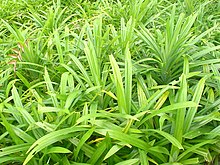Pandanus amaryllifolius
| Pandanus amaryllifolius | |
|---|---|

| |
| Scientific classification | |
| Kingdom: | Plantae |
| Clade: | Tracheophytes |
| Clade: | Angiosperms |
| Clade: | Monocots |
| Order: | Pandanales |
| Family: | Pandanaceae |
| Genus: | Pandanus |
| Species: | P. amaryllifolius
|
| Binomial name | |
| Pandanus amaryllifolius | |
| Synonyms[1] | |
| |
Pandanus amaryllifolius is a tropical plant in the Pandanus (screwpine) genus, which is commonly known as 'Pandan’ (/ˈpændən/), and is used widely in South Asian and Southeast Asian cooking as a flavoring.
Botanical features
The characteristic aroma of pandan is caused by the aroma compound 2-acetyl-1-pyrroline, which may give white bread, jasmine rice and basmati rice (as well as bread flowers Vallaris glabra) their typical smell.[2] The plant is rare in the wild but is widely cultivated. It is an upright, green plant with fan-shaped sprays of long, narrow, blade-like leaves and woody aerial roots. The plant is sterile, with flowers only growing very rarely, and is propagated by cuttings.[citation needed]
Culinary use
In India and Sri Lanka it is called Rampé in Bangladesh it is called pulao pata (পোলাও পাতা ), and in Maldives it is called Ran’baa along with the other variety of pandan there (Pandanus fascicularis), and is used to enhance the flavor of pulao, biryani and sweet coconut rice pudding, payesh if basmati rice is not used. It acts as a cheap substitute for basmati fragrance as one can use normal, non-fragrant rice and with the help of pandan the dish tastes and smells like basmati is used. It is called Ambemohor pat in Marathi; Ramba in Tamil, Biriyanikaitha in Malayalam, pandan wangi in Indonesian, hsun hmway (‹See Tfd›ဆွမ်းမွှေး) in Burmese, pandan in Visayan languages and Tagalog, ใบเตย bai tooey in Thai, rampe (රම්පෙ) in Sinhala, ស្លឹកតើយ sleuk toi in Khmer, Daun Pandan in Nonya cooking,[3] Dứa thơm/lá nếp in Vietnamese, 七葉蘭 (Pinyin: Qī yèlán, lit. "Seven-leaf orchid") in Chinese and बासमतिया पौधा ([bɑːsmət̪ɪjɑː pɑʊd̪ʱɑː]; "fragrant plant") in Magahi and Bhojpuri due to its fragrance.
The leaves are used either fresh or dried, and are commercially available in frozen form in Asian grocery stores of nations where the plant does not grow. They have a nutty, botanical fragrance that is used as a flavor enhancer in Indian, Bangladeshi, Sri Lankan, Maldivian, Burmese, Chinese, Malaysian, Vietnamese, Khmer, Laotian, Thai, Singaporean, Bruneian, Indonesian and Filipino cuisines, especially in rice dishes, desserts and cakes.

The leaves are sometimes steeped in coconut milk, which is then added to the dish. They may be tied in a bunch and cooked with the food. They may be woven into a basket which is used as a pot for cooking rice. Pandan chicken, (Thai: ไก่ห่อใบเตย, kai hor bai toei), is a dish of chicken parts wrapped in pandan leaves and fried. The leaves are also used as a flavoring for desserts such as pandan cake and sweet beverages. Filipino cuisine uses pandan as a flavoring in buko pandan fruit salad, as well as rice-based pastries such as suman and numerous sweet drinks and desserts.[4]
Bottled Pandan extract is available in shops, and often contains green food coloring.
Use in traditional medicine
Pandanus amaryllifolius leaves have a number of local medicinal uses. Leaf extracts have been thought to reduce fever, relieve indigestion and flatulence, and as a cardio-tonic.[5]
Use as natural air freshener
The leaves impart a pleasant aroma which can act as a natural air freshener. They are placed into a confined space, such as a car, and left there until they wither and dry up.
Notes
- ^ "The Plant List: A Working List of All Plant Species". Retrieved 29 March 2015.
- ^ Wongpornchai et al. (2003).
- ^ "Duan Pandan or Screwpine Leaves – Nonya Cooking Ingredient". Archived from the original on 7 August 2012. Retrieved 5 August 2012.
{{cite web}}: Unknown parameter|dead-url=ignored (|url-status=suggested) (help) - ^ IJsselstein. "Lyn's Recipes Corner". Buko Pandan Salad. Jeroen Hellingman. Archived from the original on 26 October 2011. Retrieved 18 October 2011.
{{cite web}}: Unknown parameter|dead-url=ignored (|url-status=suggested) (help) - ^ N., Cheeptham,; G.H.N., Towers,. "Light-mediated activities of some Thai medicinal plant teas". Fitoterapia. 73 (7–8). Archived from the original on 18 July 2017. Retrieved 2 December 2017.
{{cite journal}}: Unknown parameter|dead-url=ignored (|url-status=suggested) (help)CS1 maint: extra punctuation (link) CS1 maint: multiple names: authors list (link)
References
- Li J. and Ho S.H. (2003). Pandan leaves (Pandanus amaryllifolius Roxb.) as a Natural Cockroach Repellent. Proceedings of the 9th National Undergraduate Research Opportunities Programme (2003-09-13).
- Van Wyk, Ben-Erik (2005). Food Plants of the World. Portland, Oregon: Timber Press, Inc. ISBN 0-88192-743-0
- Wongpornchai, S.; Sriseadka, T.; Choonvisase, S. (2003). "Identification and quantitation of the rice aroma compound, 2-acetyl-1-pyrroline, in bread flowers (Vallaris glabra Ktze)". J. Agric. Food Chem. 51 (2): 457–462. doi:10.1021/jf025856x. PMID 12517110.
{{cite journal}}: Unknown parameter|last-author-amp=ignored (|name-list-style=suggested) (help)

